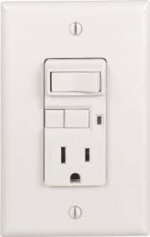Vince67
Member
- Location
- Kailua, HI
- Occupation
- Electrician/Electrical Contractor
Hi All,
I am working on a new pool that has a total of (12)120v LED light fixtures with a total 7.2amps. Six lights on one side, six on the other.
Being supplied from at 20a Siemens GFI bolt-on breaker.
Breaker supplies a switch and from the switch it controls the right and left sides. The switch is approximately 100' from the breaker.
My problem exists on the left bank of lights which is approximately 100' from the switch at the last connection point. When the switch is activated the circuit trips 100% of the time.
The right bank of lights works 100% of the time and the furthest connection point is approx. 50 feet from the switch.
The entire circuit is supplied with #10 THHN with no voltage drop.
I have replaced the breaker and the wires from the switch to the junction boxes and I can get a combination of the 6 pool lights to work. And then when the switch is turned off the same combination will trip the circuit when turned back on.
I have isolated the right bank from the left bank and have applied each individual light (6) from the left side onto the energized circuit without the GFI breaker tripping. I have also had the right side bank energized and applied the left bank lights one at a time and the circuit holds.
The left side lights trip with the rush of incoming current when the switch is applied or even when I bypass the switch and comes from the breaker.
I've had 6 brand new lights in their boxes, applied to the circuit and the GFI breaker held. I re-tested the lights in the pool and the circuit tripped. So, the problem is got to be a combination of the lights in the pool.
We did another test, cut an extension cord and applied all 12 lights and plugged it into a GFI outlet and it held. Maybe it's not the pool lights?
The Siemans breaker has a 5 Milliamp trip rating which is not handling the in rush of current. The GFI outlet has a 4-6 MA trip rating and is holding when plugged in.
Would the total footage of the circuit affect the 5 Milliamp GFI breaker at 3.6a and cause it to trip?
There's a 30 milliamp breaker available and this is my next option, I'm just not sure that this will solve my problem.
Thanks
Vince
I am working on a new pool that has a total of (12)120v LED light fixtures with a total 7.2amps. Six lights on one side, six on the other.
Being supplied from at 20a Siemens GFI bolt-on breaker.
Breaker supplies a switch and from the switch it controls the right and left sides. The switch is approximately 100' from the breaker.
My problem exists on the left bank of lights which is approximately 100' from the switch at the last connection point. When the switch is activated the circuit trips 100% of the time.
The right bank of lights works 100% of the time and the furthest connection point is approx. 50 feet from the switch.
The entire circuit is supplied with #10 THHN with no voltage drop.
I have replaced the breaker and the wires from the switch to the junction boxes and I can get a combination of the 6 pool lights to work. And then when the switch is turned off the same combination will trip the circuit when turned back on.
I have isolated the right bank from the left bank and have applied each individual light (6) from the left side onto the energized circuit without the GFI breaker tripping. I have also had the right side bank energized and applied the left bank lights one at a time and the circuit holds.
The left side lights trip with the rush of incoming current when the switch is applied or even when I bypass the switch and comes from the breaker.
I've had 6 brand new lights in their boxes, applied to the circuit and the GFI breaker held. I re-tested the lights in the pool and the circuit tripped. So, the problem is got to be a combination of the lights in the pool.
We did another test, cut an extension cord and applied all 12 lights and plugged it into a GFI outlet and it held. Maybe it's not the pool lights?
The Siemans breaker has a 5 Milliamp trip rating which is not handling the in rush of current. The GFI outlet has a 4-6 MA trip rating and is holding when plugged in.
Would the total footage of the circuit affect the 5 Milliamp GFI breaker at 3.6a and cause it to trip?
There's a 30 milliamp breaker available and this is my next option, I'm just not sure that this will solve my problem.
Thanks
Vince


